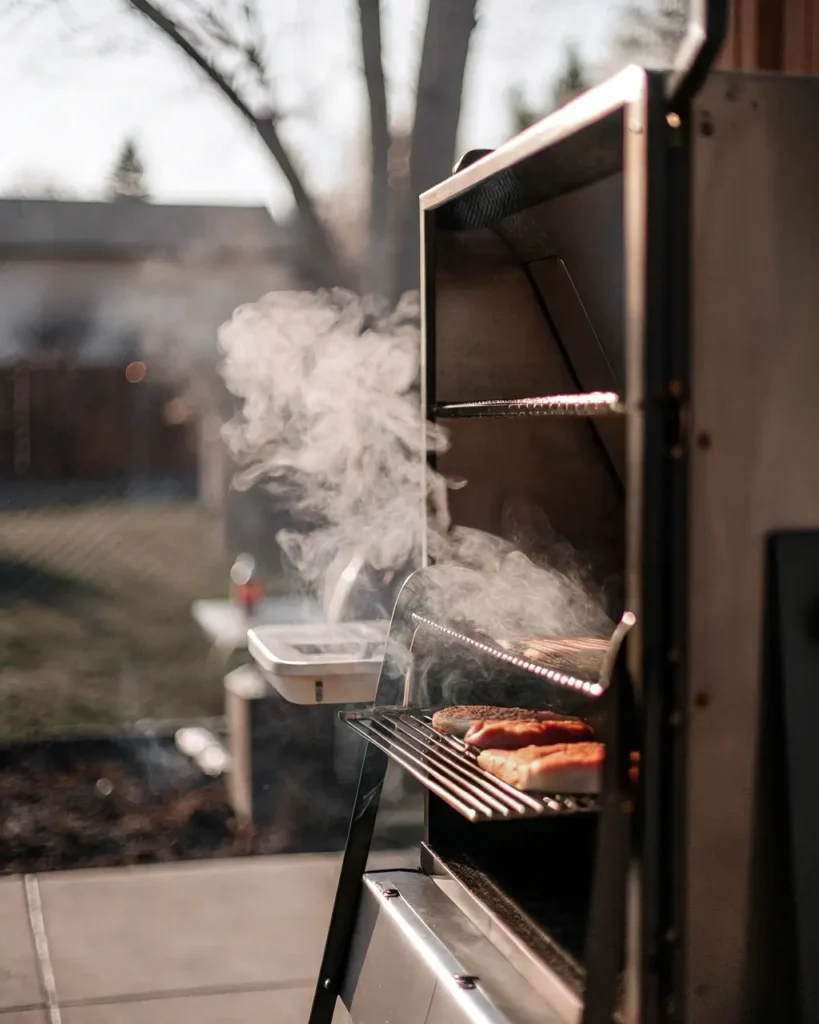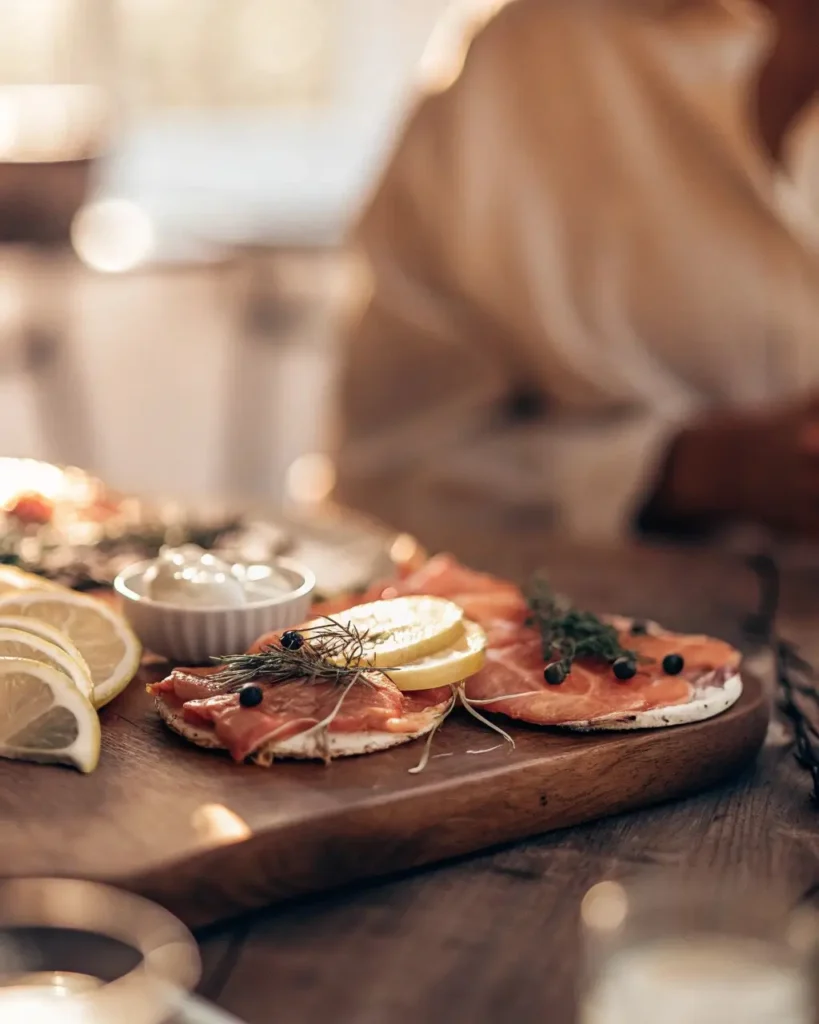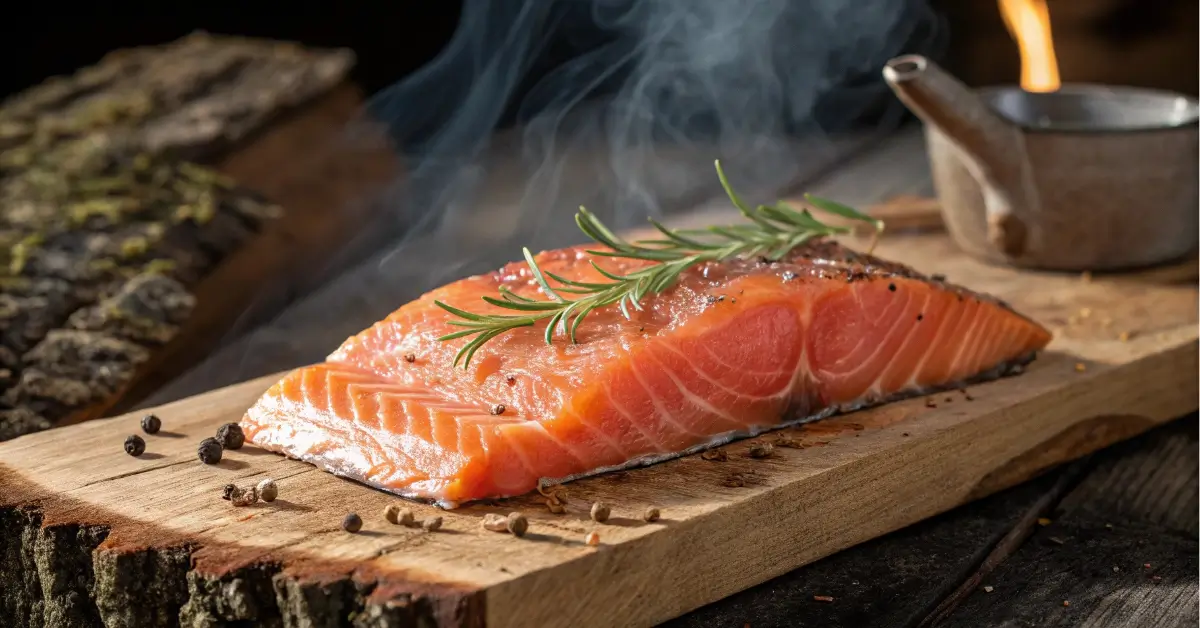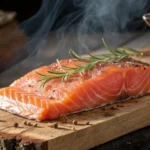Smoking your own salmon can feel intimidating, but once you understand how to smoke salmon in a smoker, it quickly becomes one of the most satisfying culinary skills you’ll master. In this guide, we’ll take you step-by-step through everything you need to know—from picking the right fish, prepping it correctly, and setting up your smoker, to mastering time and temperature so your salmon turns out tender, flavorful, and perfectly smoked every single time.
If you’re new to smoking or simply looking to improve your game, this post will break it all down into digestible parts, making your journey from raw fish to mouthwatering smoked salmon as smooth as possible. We’ll cover different smoking methods, best wood choices, brining tips, smoker setup, cooking duration at 225°F, and much more.
Looking for inspiration? Try this salmon bowl recipe that perfectly complements your home-smoked fish.
Jump to:
Understanding the Basics of Smoking Salmon
What is smoked salmon and why is it popular?
Smoked salmon is salmon that has been cured and then slow-cooked using smoke to infuse flavor. It’s a centuries-old method of preserving fish and has become a modern-day delicacy served on bagels, in pasta, or even as a standalone dish. When you learn how to smoke salmon in a smoker, you unlock a way to elevate home meals with rich, layered flavors you simply can’t replicate in a pan.
Smoked salmon is celebrated for its soft texture, deep smoky aroma, and subtle sweetness. It’s popular in everything from brunch spreads to fancy hors d’oeuvres. Smoking your salmon gives you full control over ingredients, allowing you to avoid preservatives or overly salty commercial versions.
Benefits of smoking salmon at home
Why go through the effort of smoking salmon yourself? For starters, it’s incredibly cost-effective. Store-bought smoked salmon can be pricey, while home smoking can yield a large batch at a fraction of the cost.
Home-smoking also lets you control:
- Flavor intensity by choosing the type of wood
- Texture and moisture by adjusting smoker temperature and duration
- Nutritional content, especially sodium levels
More importantly, the satisfaction of knowing you smoked your own fish from scratch? Totally worth it. Plus, it’s a great skill for BBQ enthusiasts or anyone who enjoys outdoor cooking.
Don’t miss our creative smoked cream cheese ideas to pair with your fish for an unforgettable smoked platter.
Choosing the Right Type of Salmon for Smoking
Best salmon cuts and species for smoking
When mastering how to smoke salmon in a smoker, one of the first decisions you’ll make is selecting the right type of salmon. Not all salmon is created equal—some cuts and species perform better in the smoker than others due to fat content, thickness, and texture.
Here are the top choices:
| Salmon Type | Flavor Profile | Best For Smoking? | Notes |
|---|---|---|---|
| King (Chinook) | Rich, buttery | ✅✅✅ | High fat = moist, flavorful result |
| Sockeye | Deep red, bold taste | ✅✅ | Leaner; needs careful smoking |
| Coho | Milder, tender | ✅✅✅ | Balanced flavor, great texture |
| Atlantic (Farmed) | Mild, consistent | ✅✅ | Readily available; watch for additives |
King salmon is the gold standard. It’s loaded with omega-3 fats that help it stay juicy throughout the smoking process. Sockeye and Coho are also fantastic, but be mindful of cooking time—leaner fish can dry out quicker.
For cuts, skin-on fillets work best. They hold together better, retain moisture, and allow the smoke to penetrate deeply without falling apart.
Discover great ideas like crispy salmon bites in the air fryer to see how different salmon types cook up.
Wild-caught vs. farm-raised salmon: What works better in a smoker?
This question comes up a lot when people ask how to smoke salmon in a smoker: should I use wild-caught or farm-raised fish?
Here’s the breakdown:
- Wild-caught salmon tends to be leaner with stronger flavor. It’s more delicate, so you need to be cautious with timing and heat. It’s ideal for experienced smokers who want a bold flavor.
- Farm-raised salmon, especially Atlantic varieties, generally have higher fat content and a milder flavor. This makes them forgiving and perfect for beginners.
For most people starting out, farm-raised is a solid choice. It handles smoke well, offers a consistent thickness, and delivers that moist, flaky texture everyone loves in smoked salmon.
Don’t miss our baked salmon bites recipe that’s great for testing different salmon textures before you smoke.
Prepping Your Salmon for the Smoker
Should you brine your salmon before smoking?
If you’re serious about learning how to smoke salmon in a smoker, the brining process is one step you shouldn’t skip. Brining enhances the flavor, helps the fish retain moisture, and contributes to that signature silky texture in every bite.
There are two types of brining:
| Brine Type | Description | Duration |
|---|---|---|
| Wet Brine | A salty, sugar-based water solution | 8–12 hours |
| Dry Brine | A dry mix of salt and sugar rubbed on | 4–8 hours |
Wet brining involves submerging the salmon in a liquid solution made of salt, brown sugar, and water. You can also add spices like garlic, lemon zest, or dill for flavor infusion. For a more intense flavor, a dry brine rub draws out moisture and lets the salmon reabsorb the flavors over time.
If you’re short on time, go with a dry brine. But for a juicier outcome, the wet brine is your best friend.
Looking for inspiration? Try this apple and honey-glazed chicken recipe to get a sense of how sweet elements like honey complement smoked proteins.
How to remove bones and prep the skin for smoking
Before your salmon hits the smoker, you need to do a little surgery. Prep is critical to ensure even smoking and that each bite is bone-free and delicious.
Here’s how to prep your salmon fillet:
- Check for pin bones: Run your fingers along the flesh side of the fillet. If you feel small, sharp bits poking up, use tweezers or pliers to pull them out.
- Rinse and pat dry: After brining, rinse off the excess salt or sugar and thoroughly pat the fish dry with paper towels. This helps the pellicle (a thin tacky layer) form, which is essential for smoke adherence.
- Keep the skin on: This is optional but highly recommended. The skin helps hold the fillet together and keeps moisture in during the smoking process.
If you want to experiment with smoky-sweet flavor profiles, check out our sugar-free caramel syrup as a glaze alternative before smoking.

Setting Up Your Smoker Properly
Best types of smokers for salmon (electric, pellet, charcoal)
If you’re serious about learning how to smoke salmon in a smoker, the first step is understanding your equipment. Your choice of smoker will directly impact the flavor and ease of the smoking process. Not all smokers are created equal, especially when it comes to delicate fish like salmon.
Here’s a quick breakdown of the best smoker types:
| Smoker Type | Flavor Output | Ease of Use | Best For |
|---|---|---|---|
| Electric | Mild smoke | ⭐⭐⭐⭐⭐ | Beginners who want easy setup |
| Pellet | Balanced smoke | ⭐⭐⭐⭐ | Intermediate users |
| Charcoal | Strong flavor | ⭐⭐ | Experienced BBQ fans |
| Offset/Stick Burner | Bold smoke | ⭐ | Pros seeking full control |
If you’re just starting to explore how to smoke salmon in a smoker, an electric smoker is ideal. It keeps the temperature stable and requires minimal babysitting. Pellet smokers are also a strong choice for precise temperature control and balanced smoke flavor.
Charcoal and offset smokers are better suited for pitmasters who already have some experience and want a rich, traditional smokehouse taste.
Want a fun, beginner-friendly recipe to test your smoker? Don’t miss our how to smoke cream cheese step-by-step guide.
Temperature guidelines: Why 225°F is the sweet spot
Mastering how to smoke salmon in a smoker means understanding the power of low and slow heat. The magic number here is 225°F—it’s the sweet spot that cooks salmon gently while infusing the right amount of smoky flavor.
Why 225°F works:
- It preserves moisture and prevents overcooking
- It allows smoke to penetrate the fillet evenly
- It avoids cooking the salmon too fast, which can toughen the flesh
Time-to-temp guide:
Smoke your salmon at 225°F until the internal temperature hits 135°F for soft texture or 145°F for firm doneness. Always use a meat thermometer for accuracy.
Quick tips for setup success:
- Preheat your smoker for 20–30 minutes before placing the salmon in
- Use a water pan to maintain humidity
- Don’t open the smoker often—it drops the temp and releases smoke
Want more smoker-based dinner ideas? Check out our chicken thigh and hominy casserole—a low-and-slow dish that pairs perfectly with smoked meats.

The Smoking Process Step-by-Step
How to season and place your salmon in the smoker
When it’s finally time to put your salmon in the smoker, it all starts with smart seasoning and placement. Here’s a practical guide for making the most of your effort to master how to smoke salmon in a smoker.
Seasoning tips:
- Keep it simple: Start with salt, pepper, and a little brown sugar.
- Add depth: Mix in garlic powder, dill, paprika, or a citrus zest.
- Optional glaze: Brush a light maple syrup or honey mustard blend 30 minutes before the salmon finishes.
Placement matters:
- Place the salmon skin-side down on the grates or on a lightly oiled wire rack.
- Allow space between fillets for even smoke flow.
- Add a drip pan beneath the fish to prevent flare-ups and keep moisture in the chamber.
Use a water pan in your smoker to help regulate humidity, which helps prevent your salmon from drying out. And remember: don’t overcrowd the smoker—air and smoke circulation are key.
Check out shaved ribeye recipes to try another smoke-friendly meat after you’ve mastered salmon.
How long to smoke salmon at 225°F and what to watch for
Time is everything when smoking fish. At 225°F, your salmon needs the right balance of cook time and temperature control to become moist, flaky, and infused with that irresistible smoky flavor.
General rule of thumb:
- Smoke for 30–45 minutes per pound
- Or until the internal temp reaches 135°F to 145°F, depending on your texture preference
| Weight of Salmon | Approximate Smoke Time |
|---|---|
| 1 lb fillet | 45–60 minutes |
| 2 lbs | 1.5–2 hours |
| 3 lbs | 2–2.5 hours |
What to watch for:
- White protein (albumin) rising to the surface? It’s a sign the salmon is cooking too fast—reduce the heat.
- The flesh should flake easily with a fork, but still look moist and slightly glossy inside.
Don’t open the smoker too often—heat and smoke escape each time you do, extending the cooking time. Instead, rely on a probe thermometer to track progress.
Discover great ideas like San Antonio grilled Mexican chicken if you want to diversify your smoker-friendly proteins.
Expert Smoking Tips to Elevate Flavor
Using wood chips: Applewood, cherry, hickory – what’s best for salmon?
When learning how to smoke salmon in a smoker, choosing the right wood can make or break the flavor. Different wood types release unique aromas and flavor profiles. For salmon, the goal is to complement the fish’s natural richness without overwhelming it.
Here’s a quick breakdown of the best wood options for salmon:
| Wood Type | Flavor Profile | Best Use |
|---|---|---|
| Applewood | Sweet, fruity | Mild and well-balanced flavor |
| Cherry | Mildly sweet, subtle | Adds a beautiful mahogany hue |
| Hickory | Strong, bold | Use sparingly or mix with fruitwoods |
| Maple | Slightly sweet, smooth | Ideal for glazed or brined fish |
| Alder | Light, clean, classic | Traditional choice for fish |
Pro Tip: Mix fruitwoods like apple or cherry with a small amount of hickory for a custom smoky depth without overpowering the salmon.
Avoid mesquite or oak for salmon—they’re too intense and can leave a bitter aftertaste.
If you’re experimenting with woods and flavor combinations, take a look at essential smoked cream cheese seasonings for fun pairings.
To wrap or not to wrap: Should you use foil when smoking salmon?
This is one of the most debated topics when discussing how to smoke salmon in a smoker. Some people wrap salmon in foil to keep it moist, while others prefer direct exposure to maximize smoke absorption.
Here’s a breakdown:
| Method | Pros | Cons |
|---|---|---|
| Wrapped in foil | Retains moisture, easier cleanup | Less smoke flavor, softer bark |
| Unwrapped | Richer smoke flavor, crispier edge | Risk of drying out |
| Foil tented (partially wrapped) | Balanced method | Allows some smoke while trapping moisture |
Best practice? Start unwrapped for the first 75% of the cook time to let the smoke work its magic. Then loosely wrap or tent with foil in the final stretch to keep the salmon juicy.
For a different twist, try applying a maple syrup glaze before wrapping. It caramelizes slightly, forming a sweet-savory crust.
Don’t miss our cheesy chicken sloppy joe recipe if you’re looking to complement your smoked dishes with something rich and indulgent.
Finishing and Serving Your Smoked Salmon
How to know when your smoked salmon is done
Once you’ve followed all the steps to learn how to smoke salmon in a smoker, it’s time to nail the final step: knowing when your salmon is done. A properly smoked salmon is moist, flaky, and packed with deep smoky flavor—not dry or undercooked.
Look for these signs of doneness:
- Internal temperature: 135°F for a softer, buttery texture or 145°F for fully cooked
- Appearance: Lightly golden-pink exterior with a glossy finish
- Texture: Should flake easily with a fork but still feel firm and moist
- No raw spots: Check the thickest part of the fillet to ensure it’s cooked through
If you’re still uncertain about timing, use a meat thermometer and aim for consistency. Remember, the more you practice how to smoke salmon in a smoker, the easier it becomes to read visual and textural cues.
Got leftovers? Turn them into a delicious meal with our classic salmon patty recipe.
Creative serving ideas and smoked salmon recipes
One of the best parts of learning how to smoke salmon in a smoker is discovering all the ways to enjoy it once it’s done. Smoked salmon is incredibly versatile and works in dishes for breakfast, lunch, dinner, or even appetizers.
Here are some creative serving options:
- Smoked Salmon Bagel Bar: Layer cream cheese, thin salmon slices, capers, and red onion on an everything bagel
- Smoked Salmon Flatbreads: Add arugula, goat cheese, and balsamic drizzle for a gourmet snack
- Fish Tacos: Use warm tortillas, shredded cabbage, and chipotle sauce
- Smoked Salmon Quiche: Perfect for brunch or make-ahead breakfast
- Pasta Salad with Smoked Salmon: Cold pasta, fresh herbs, lemon, and a creamy dressing
Don’t forget the pairings—white wine, dill pickles, or even hard-boiled eggs make excellent companions for your salmon.

Wrap up the meal on a sweet note with our protein cookie dough bites—a healthy dessert that’s low in sugar but big on flavor.
Troubleshooting Common Smoking Issues
Why is my smoked salmon too dry or too soft?
Even when you follow every step, things can go wrong—and that’s okay. If you’re still figuring out how to smoke salmon in a smoker, here are some common texture problems and how to fix them.
Too dry? That’s usually caused by:
- Smoking at too high a temperature (above 250°F)
- Leaving it in too long—watch the time and weight
- No water pan in the smoker to help with humidity
- No brining or improper brine time
Solution: Use a wet brine, monitor your smoker with a dual-probe thermometer, and keep the temp locked at 225°F. Also, loosely tent with foil in the final 25% of cook time to trap in moisture.
Too soft or mushy? You might be:
- Over-brining, especially with dry brines
- Not drying the salmon well enough before smoking
- Smoking at too low a temperature for too short a time
Solution: Always let the brined salmon air-dry on a rack for 1–2 hours before smoking. This forms the pellicle, a tacky surface that allows the smoke to adhere and the fish to firm up.
Want more tips on texture perfection? Explore how long to cook salmon bites in the oven to compare different cooking outcomes.
Fixing flavor imbalances and texture problems
Nailed the texture but not the taste? It happens. Here’s how to troubleshoot the flavor side of how to smoke salmon in a smoker:
| Problem | Likely Cause | Fix |
|---|---|---|
| Too salty | Over-brining or not rinsing well | Reduce brine time, rinse thoroughly |
| Bitter taste | Using too much or strong wood like mesquite | Use lighter woods like apple or cherry |
| Too bland | Underseasoned or short smoke time | Add rubs, longer smoke, try wood blends |
| Overpowering smoke | Low-quality wood or dirty smoker | Use food-grade chips; clean smoker often |
Extra Tip: Don’t be afraid to experiment in small batches. Tweak your brine, wood choice, and cook time based on the results—and take notes!
Looking for flavor inspiration? Try our churu chicken amarillo for bold seasoning ideas that can cross over into fish smoking.
Storing and Reheating Smoked Salmon
How to store smoked salmon for maximum freshness
After you’ve nailed how to smoke salmon in a smoker, proper storage becomes the next priority. Improper storage can turn beautifully smoked fish into a soggy, unappetizing mess—or worse, a food safety hazard.
Here’s how to keep your smoked salmon fresh and delicious:
| Storage Method | Shelf Life | Notes |
|---|---|---|
| Refrigerator (sealed) | 5–7 days | Use airtight containers or vacuum-sealed bags |
| Freezer (vacuum sealed) | Up to 3 months | Best to slice before freezing for easy use |
| Fridge (unwrapped) | 1–2 days | Risk of drying out, losing flavor |
Storage tips:
- Always let salmon cool to room temp before refrigerating.
- Place a paper towel inside the container to absorb moisture.
- Label and date your containers to avoid confusion.
If you’re storing large batches, divide them into portions before freezing so you only defrost what you need.
Looking for ideas to pair with leftover smoked salmon? Try our protein popcorn recipe for a healthy, high-protein snack combo.
Best ways to reheat smoked salmon without losing flavor
When learning how to smoke salmon in a smoker, it’s important to remember that reheating is more of an art than a science. Done wrong, and you’ll dry it out or make it rubbery.
Here are a few smart ways to warm it up without losing that rich smoked flavor:
Oven (Best Method):
- Preheat to 275°F
- Wrap salmon in foil with a bit of olive oil or butter
- Heat for 10–15 minutes
Steamer:
- Place in a steaming basket over simmering water
- Steam for 5–7 minutes
- Helps preserve moisture better than dry heat
Microwave (Least Recommended):
- Use only for small portions
- Cover with a damp paper towel
- Heat in 20-second bursts on low power
Avoid high heat and long cook times. Smoked salmon is delicate—treat it like the premium protein it is.
If you’re planning a full meal around your reheated fish, don’t miss our coconut clusters recipe as a tropical-inspired dessert pairing.
Frequently asked questions
How long does salmon take to smoke at 225 degrees?
At 225°F, salmon typically takes 30 to 45 minutes per pound to smoke. Smaller fillets may take 1 to 1.5 hours, while whole sides could need up to 2.5 hours. Always aim for an internal temperature of 135°F to 145°F depending on your desired texture.
Do I have to brine my salmon before smoking?
While it’s not strictly required, brining is highly recommended. A wet or dry brine helps preserve moisture, enhances flavor, and aids in the formation of the pellicle—the tacky surface that holds smoke. Without brining, your salmon may turn out dry and underseasoned.
Do you wrap salmon in foil when smoking?
Wrapping salmon in foil is optional. It helps retain moisture and simplifies cleanup but reduces smoke penetration. For best results, start unwrapped, then tent with foil during the last 25% of the smoking time to keep the fish juicy.
Do you skin salmon before smoking?
No, it’s best to leave the skin on when smoking salmon. The skin helps hold the fillet together, prevents sticking, and locks in moisture. You can easily remove the skin after smoking if desired.
How long should salmon sit out before smoking?
Letting salmon rest at room temperature for 20–30 minutes before smoking promotes even cooking. This step also helps the pellicle form after brining, allowing smoke to adhere more effectively.
Is salmon good in the smoker?
Absolutely. Smoking transforms salmon into a tender, flavorful, and slightly sweet delicacy. It’s one of the most popular proteins to smoke due to its fat content and ability to absorb smoke beautifully.
Conclusion
You now know exactly how to smoke salmon in a smoker—from choosing the right cut to brining, seasoning, smoking, and serving. With the right technique, tools, and a little patience, you can create restaurant-quality smoked salmon at home with ease.
Whether you’re smoking for the first time or refining your method, remember: low and slow is the way to go. Invest in good salmon, use quality wood, and don’t skip the prep—because each step matters.
Looking for inspiration? Try our southern salmon patties recipe as a creative way to use your leftovers.
PrintHow to Smoke Salmon in a Smoker
Learn how to smoke salmon in a smoker with this step-by-step guide. Perfectly flavored and moist smoked salmon, ideal for meals, appetizers, or special occasions.
- Prep Time: 10 minutes (plus 8–12 hours brining)
- Cook Time: 2–4 hours
- Total Time: Approximately 13 hours
- Yield: 6 servings
- Category: Seafood
- Method: Smoking
- Cuisine: American
- Diet: Gluten Free
Ingredients
- 2 lbs fresh salmon fillets (wild-caught preferred)
- 1 cup kosher salt
- 1 cup brown sugar
- Optional: 1 tsp black pepper, 1 tsp paprika, zest of 1 lemon, fresh dill sprigs
- Wood chips (alder, hickory, or applewood)
Instructions
- Remove pin bones from salmon fillets, rinse with cold water, and pat dry.
- In a bowl, mix kosher salt and brown sugar. Add optional spices or zest if desired.
- Rub the dry brine over the salmon, ensuring even coverage.
- Place the salmon on a tray, cover, and refrigerate for 8–12 hours to cure.
- Preheat the smoker to 175°F. Soak wood chips for 30 minutes, then add to the smoker.
- Rinse the brine off the salmon, pat dry, and let sit for 30 minutes to form a pellicle.
- Place the salmon on a cooling rack over a drip pan and smoke for 2–4 hours, or until the internal temperature reaches 145°F.
- Remove from the smoker, let cool slightly, and serve or store as desired.
Notes
- Details: Adjust smoking time based on fillet thickness. Thinner fillets may require less time.
- To store, refrigerate in an airtight container for up to 5 days or freeze for up to 3 months.


